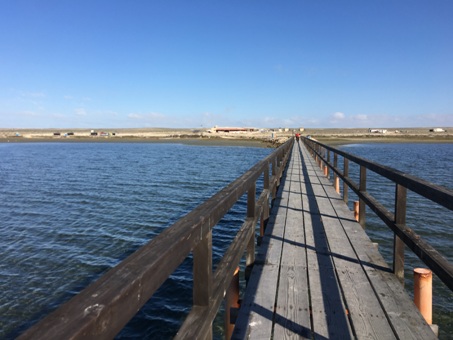BEE HIVE APR 2022
The Vizcaíno Desert — Whales
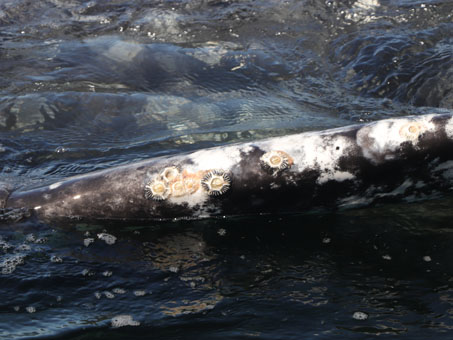 This month, we revisit the Vizcaíno Desert around the towns of Guerrero Negro, Vizcaíno and Laguna Ojo de Liebre.
This month, we revisit the Vizcaíno Desert around the towns of Guerrero Negro, Vizcaíno and Laguna Ojo de Liebre.
Previous posts from the area can be found in my UC Bee blogs from June 2013, June 2014, July 2015, Dec 2018, Feb 2019, Mar 2020, Apr 2020 and Aug 2020
When there is some rainfall between July and January in this region, then February and March are usually good months for wildflower viewing. Unlike the superbloom that occurred in 2020, this year there were just lots of small patches of wildflowers. They occurred generally on sandy substrate, across the area from at least the 28th parallel (our northernmost stop) southward to San Ignacio. It was nice to see that the lupines at roadside between Guerrero Negro and Santa Rosalía that were in bloom on our initial trip to Mulegé at the end of January were still blooming madly.
I thought I´d also digress a little from some of the lovely plants we saw in February to share a few of the photos from our trip to watch gray whales in the lagoon.
Pictured above are barnacles on the pectoral fin of a young gray whale.
Near the 28th Parallel (BC - BCS border)
This area consists of a silty-sandy substrate with pockets of very low sand dunes. The area is located a few miles from the Pacific coast and is subject to strong winds both from the coast and from the north. Dominant shrubby plants are Frankenia palmeri (Frankeniaceae), Lycium spp.(Solanaceae), Atriplex julacea, A. linearis and Suaeda nigra(Chenopodiaceae). Foliose and fruitcose lichens are quite common as epiphytes on these shrubs. A few low cactus species also occur sporadically, mainly Lophocereus schottii and Cylindropuntia spp. (Cactaceae).
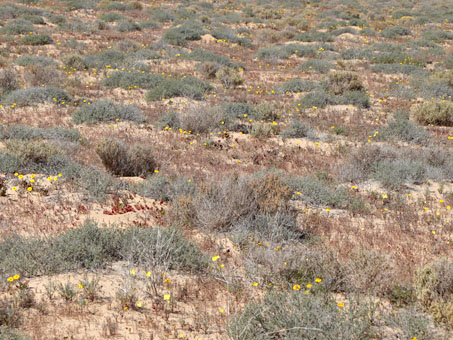
A number of annual wildflowers pop up in the sandy areas between the shrubby species (gray green plants).
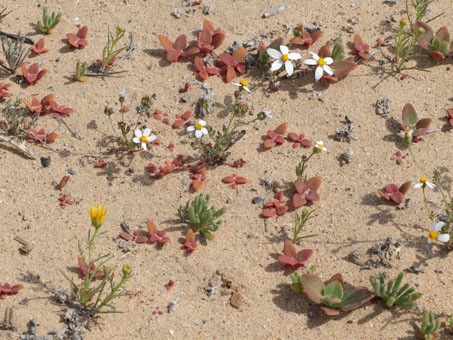
Challenge: how many different species can you find in this photo? Click on the image for a closer view. Answer at end of this page.
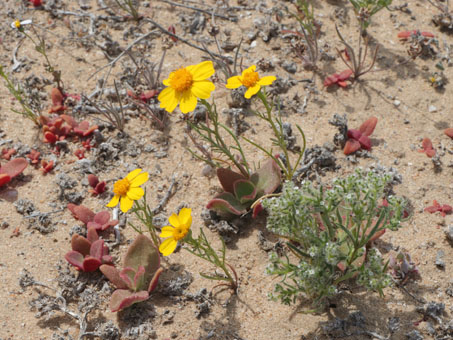
Crystalline iceplant (reddish leaves, Mesembryanthemum crystallinum, Aizoaceae), Peninsular Dyssodia (yellow, Boeberastrum anthemidifolium, Asteraceae).
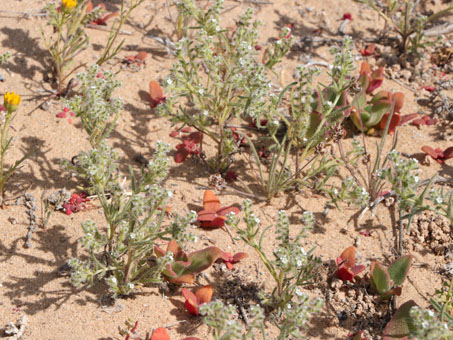
In this and the previous photo, the fuzzy green plants with minute flowers (1-2 mm D) are a species of Cryptantha (Johnstonella sp., Boraginaceae).
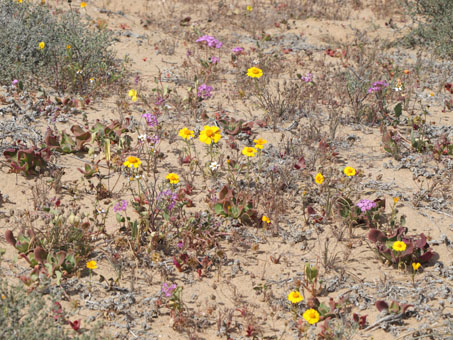
More mixed wildflowers.
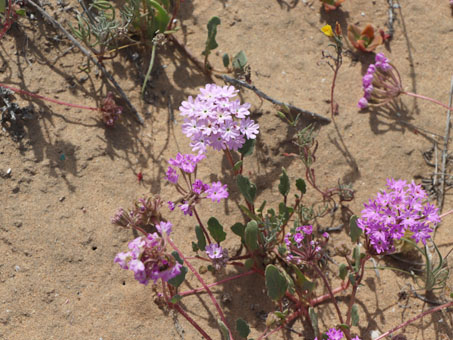
Slender Sand Verbena (Abronia gracilis, Nyctaginaceae).
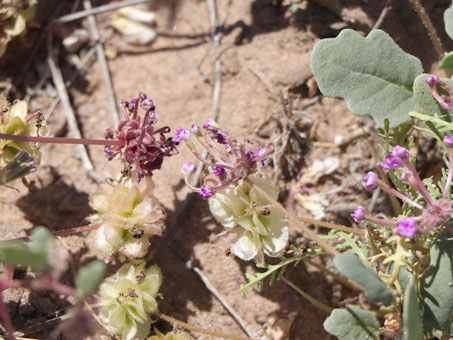
Withered flowers and fruit of Slender Sand Verbena. The fruit breaks up into papery segments that can be dispersed by the wind.
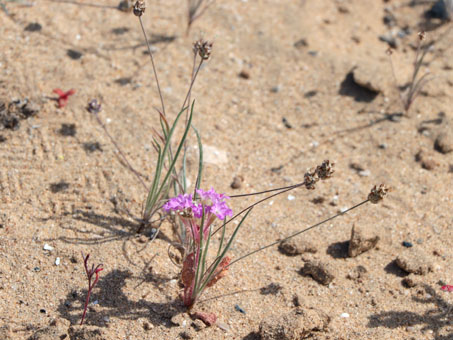
This tiny Slender Sand Verbena is even smaller than the minute Wooly Plantain (Plantago ovata, Plantaginaceae) that stands about 8 cm H.
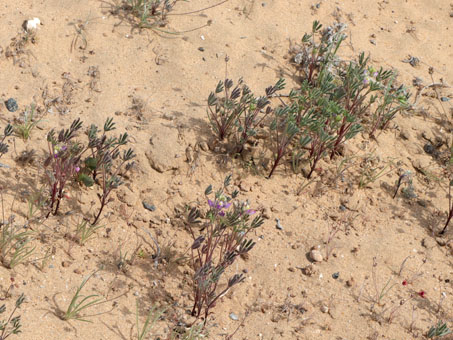
Hundreds upon hundreds of Miniature Lupine (Lupinus concinnus, Fabaceae) dominated the sandy road bank near Parallel 28.
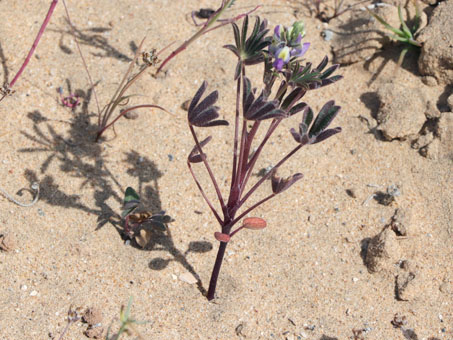
Many of the Lupines, at just 10 cm H, were already flowering. Most were no more than 20-25 cm H.
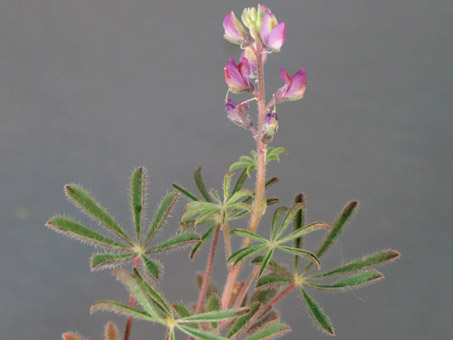
The flowers of Lupinus concinnus are only 5-12 mm, dark pink and white. The linear leaflets are 10-30 mm L x 3-4 mm W and hairy.
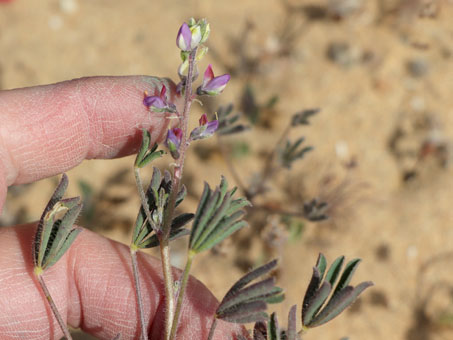
The pink or purple banner petal ages red with the white central spot aging yellow.
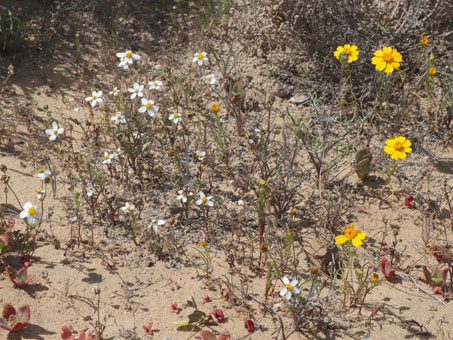
Another combination of mixed wildflowers: Coreocarpus parthenioides var. parthenioides (white, Asteraceae) along with Fetid Marigold (Boeberastrum anthemidifolium).
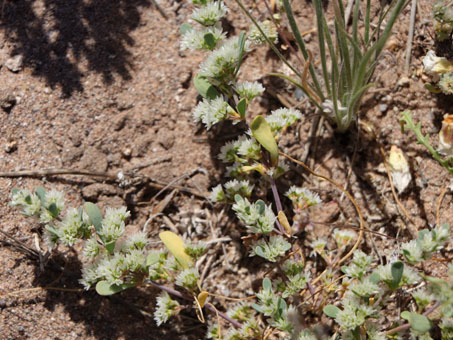
Frost-mat (Achyronychia cooperi, Caryophyllaceae). This annual reaches around 15-20 cm in size with prostrate, radiating stems. About 20-60 flowers, each 2-3 mm L, are clustered in the leaf axils.
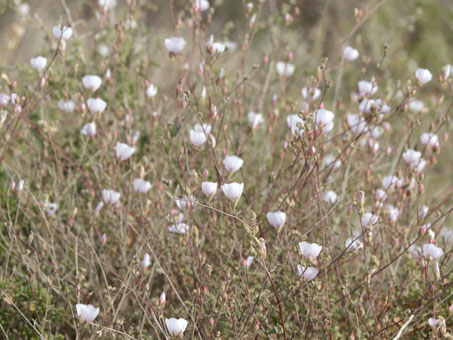
San Quintín Globemallow (Sphaeralcea fulva, Malvaceae) were blooming abundantly around Guerrero Negro.
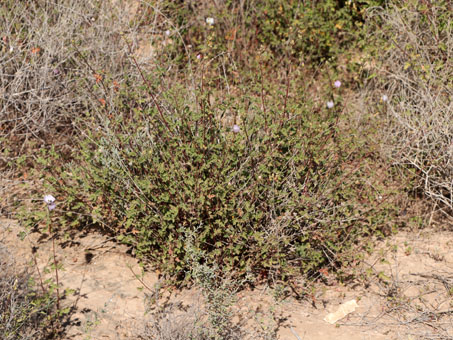
Shrubby habit of San Quintín Globemallow (Sphaeralcea fulva), a peninsular endemic found from the southside of Ensenada to the Vizcaíno desert.
Laguna Ojo de Liebre – Road to la Casa Mexicana & Whale Watching
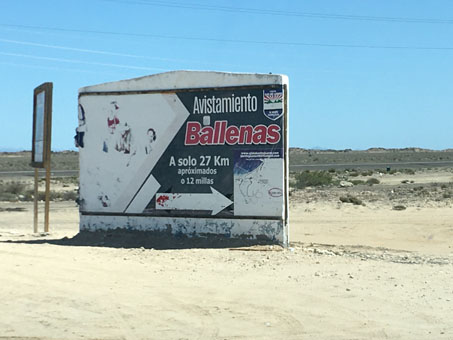 We were off to see the whales! After several days of feeling doubtful that we'd even be able to go out onto the lagoon because of the high wind and rough water, we woke to relative calm, a bit of overcast skies, and an optimistic outlook on life. We were not to be disappointed.
We were off to see the whales! After several days of feeling doubtful that we'd even be able to go out onto the lagoon because of the high wind and rough water, we woke to relative calm, a bit of overcast skies, and an optimistic outlook on life. We were not to be disappointed.
By the time we'd made the 40 minute trip from our lodgings near the 28th parallel and arrived at the Laguna, the sun was out, the wind was way down, and we could see whale spouts in the distance. We were really going to get to see the whales again. Go to my page about Mexico's Friendly Whales to learn more about their biology, natural history and conservation.
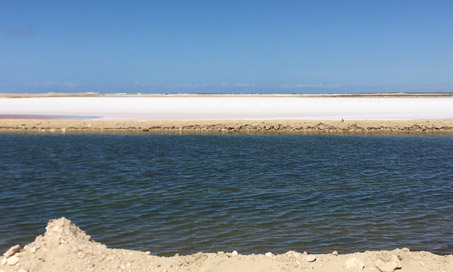
To get to Casa Mexicana, you pass through the salt pans of ESSA (Exportadora de Sal). The company produces industrial grade salt.
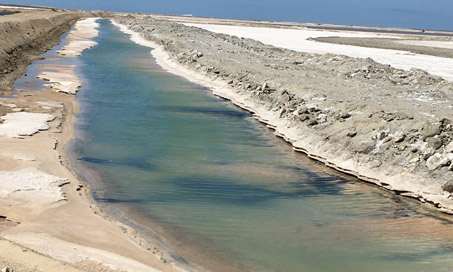
A canal with brine. The coloration comes from the different chemicals in the sea water that become concentrated as the water evaporates.
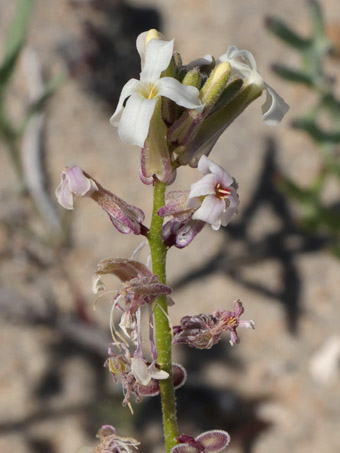
California Spectacle-pod (Dithyrea californica, Brassicaceae) flowers. Petals are 1-1.5 cm L.
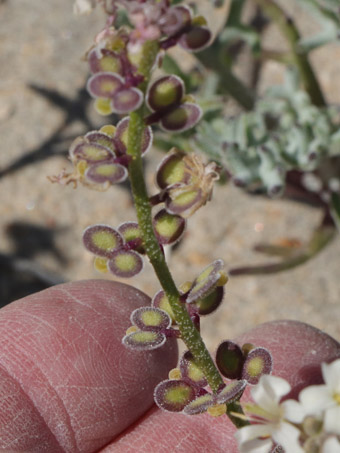
The reason for Dithyrea´s common name is pretty obvious. Each pair are about 1 cm across.
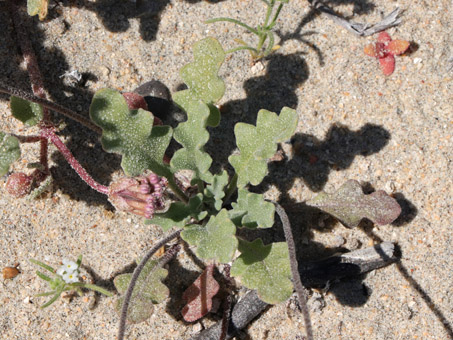
The wavy-margined basal leaves of Dithyrea.
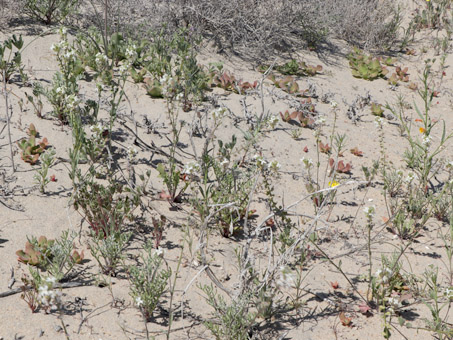
Plants were abundant in a few dunes on the way to the whales. Each was about 15-25 cm H.
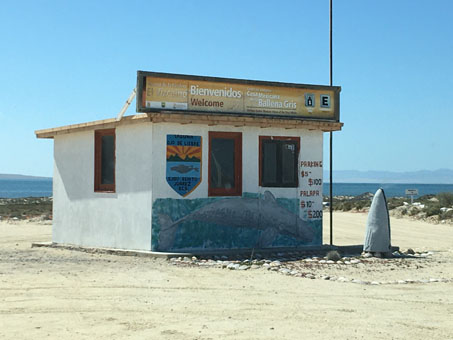
After the brief plant foray along the way, we arrived at Casa Mexicana.
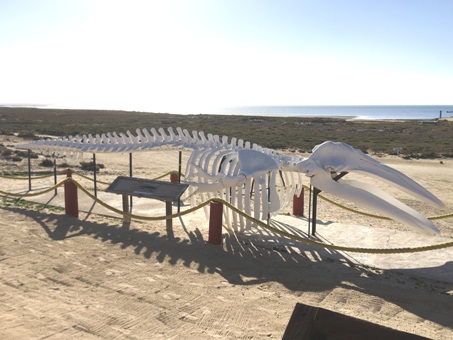
Gray Whale skelelton with Laguna Ojo de Liebre in background.
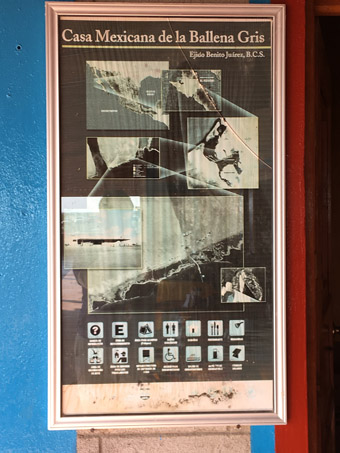
Map of the lagoon.
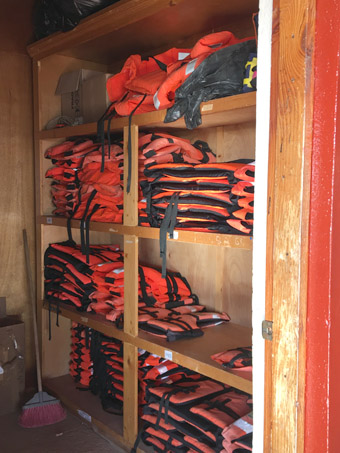
Time to go. Vests were handed out and we headed to the boat.
Looking back at Casa Mexicana as we walked out to the boat, and walked...
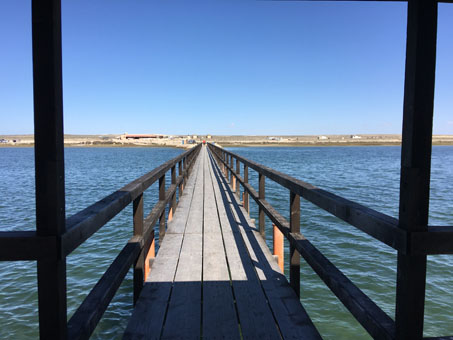
and walked...at the end of our first whale trip on the lagoon in 1990, we were dropped off somewhere near here in the mud flat at low tide and had to slog our way back on foot.
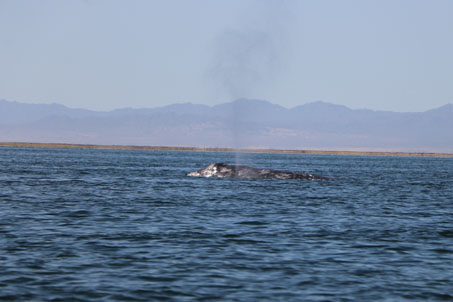
For most of our 90 minutes on the water, we saw lots of whales in the distance, doing whale things, like breathing (spouting)...
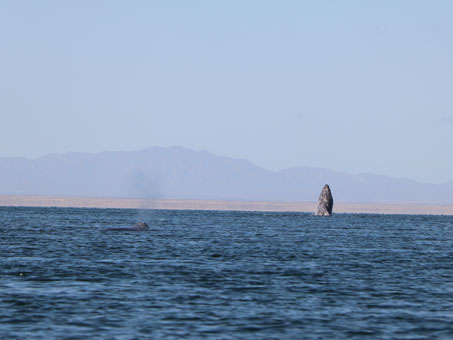
...spyhopping or, as here, breaching. We were hoping to see some babes up close, but so far, the closest things we saw were jellyfish...
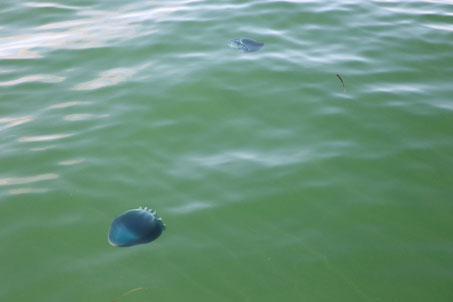
Lots of Cannonball jellyfish (Stomolophus meleagris) swimming along. We'd also seen them on our last trip about 3 years ago.
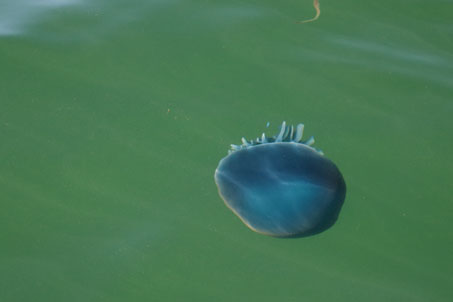
The bell-shaped Cannonball Jellyfish are about 12 cm H x 18 cm D and a beautiful blue. This is the motile, sexual phase of the organism. They are a big part of the Leatherback turtle's diet.
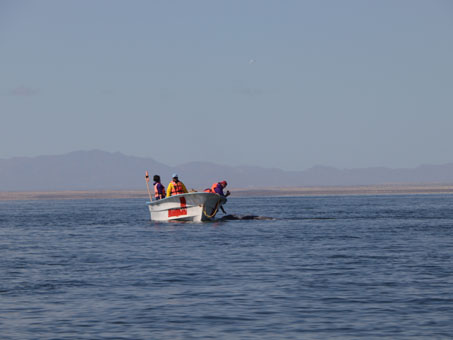
Finally, there was some activity with a baby whale at a nearby boat and our captain headed over join in.
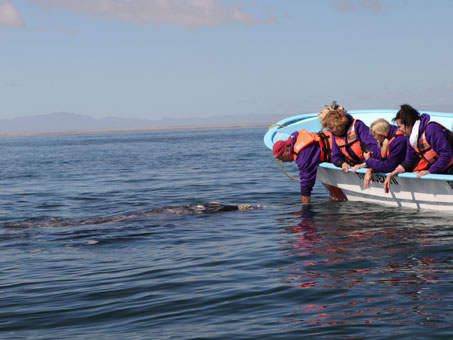
The captain of the other boat passed off "their" whale to us, and for what seemed a lifetime, we hung out with the young whales.
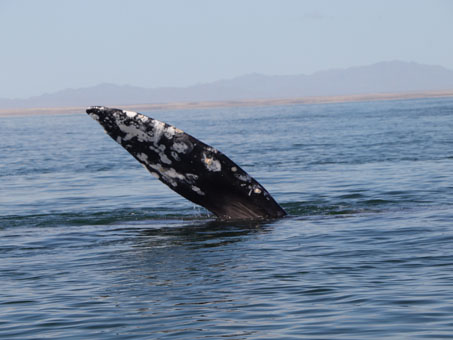
The first calf slowly swam past and gave us a wave.
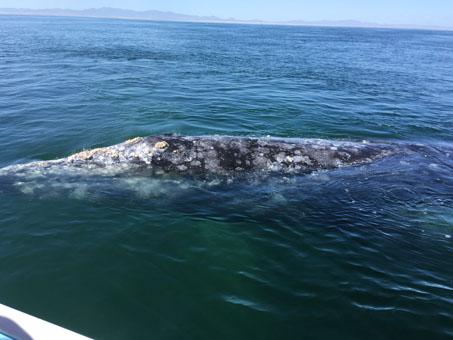
Calves are about 16 m long at birth! Longer than the boat we were in.
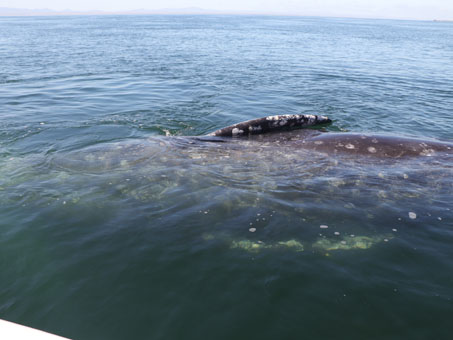
Just gliding on by on her/his side...
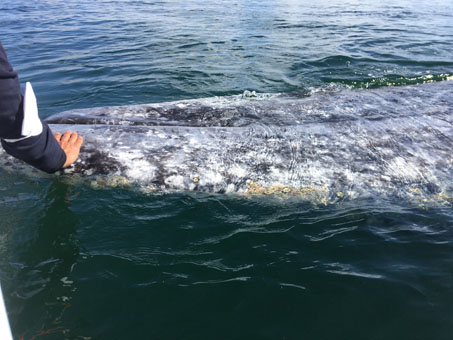
...then sidling up to get a rub.
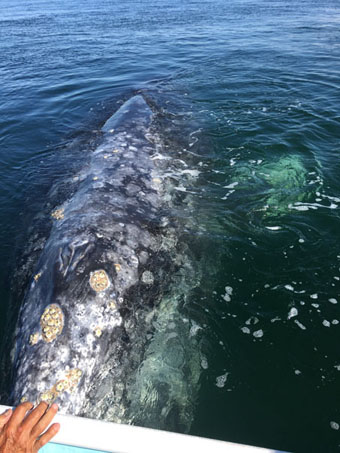
We started with one youngster but soon three others joined in...
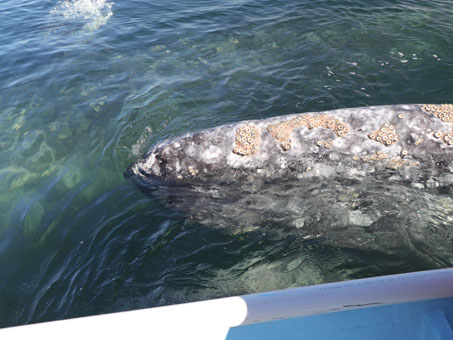
...and hung out under the boat, gently gliding past from one side to the other to make sure everyone got to pat them. Three are in this image.
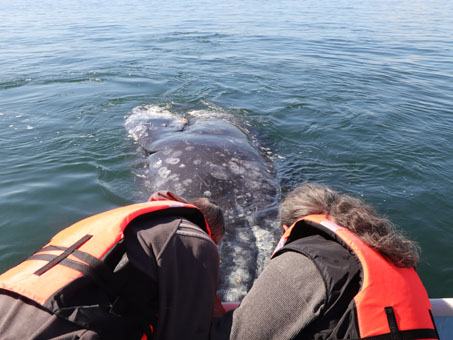
Interspecies interaction.
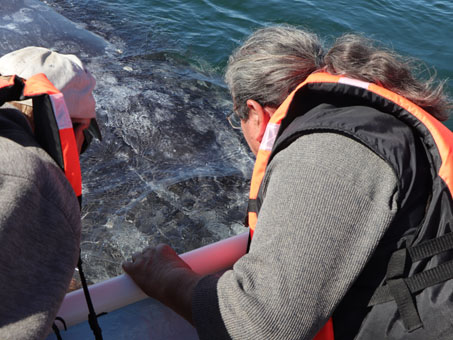
The question being, who is watching whom?
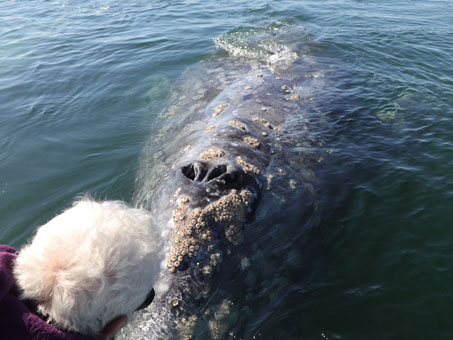
The blowhole (spiracle). When the timing was off, as the whale rose to the surface but the spiracle was still just under the water, we´d get a good soaking with salt spray as s/he took a breath.
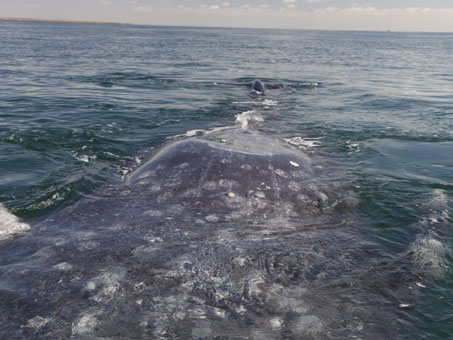
One of the larger whales...a photo I've dubbed "the aircraft carrier". The tail can be seen in the distance at the surface.
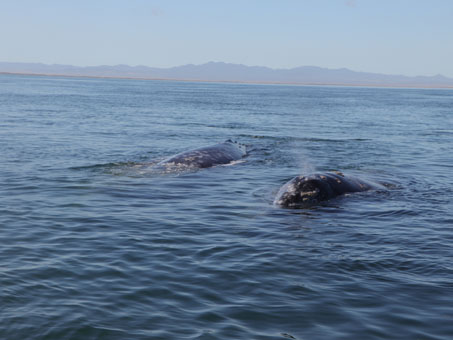
Sadly, it was time to hand off our babies to the next group. One of them raised a flipper as we pulled away.
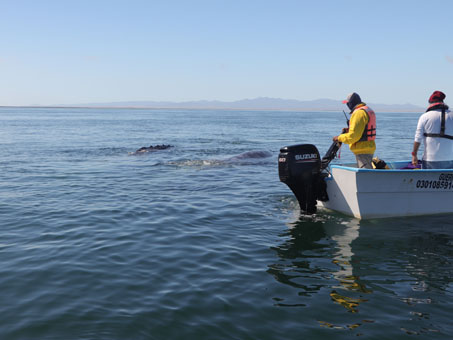
They were obviously interested in interacting because, instead of swimming off, they just moved right over to the new boat and people.
That´s it for this month. Next time, I have a few more plant photos from the Vizcaíno area. It's still very dry in Mulegé but as the weather warms up, we may have signs of Spring soon. Until next time, hasta pronto...
Debra Valov—Curatorial Volunteer
References and Resources
Rebman, J. P., J. Gibson, and K. Rich, 2016. Annotated checklist of the vascular plants of Baja California, Mexico. Proceedings of the San Diego Society of Natural History, No. 45, 15 November 2016. San Diego Natural History Museum, San Diego, CA. Full text available online.
Rebman, J. P and Roberts, N. C. (2012). Baja California Plant Field Guide. San Diego, CA: Sunbelt Publications. Descriptions and distribution.
Valov, D. (2020). An Annotated Checklist of the Vascular Plants of Mulegé, Baja California, Mexico. Madroño 67(3), 115-160, (23 December 2020). https://doi.org/10.3120/0024-9637-67.3.115
Wiggins, I. L. (1980). The Flora of Baja California. Stanford University Press. Keys and descriptions.
Challenge answer - Six species: Astragalus sp. (leaves only, mid-left); Boeberastrum anthemidifolium (bottom left, ligules visible; in bud upper right); Chaenactis lacera (top left, leaves only); Coreocarpus parthenoides var. parthenioides (white ligules), Mesembryanthemum crystallinum (wide, reddish leaves); M. nodiflorum (fleshy, cylindrical leaves).






























